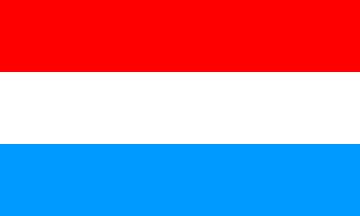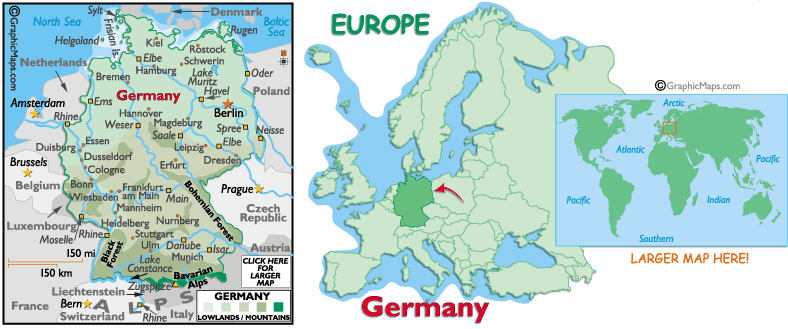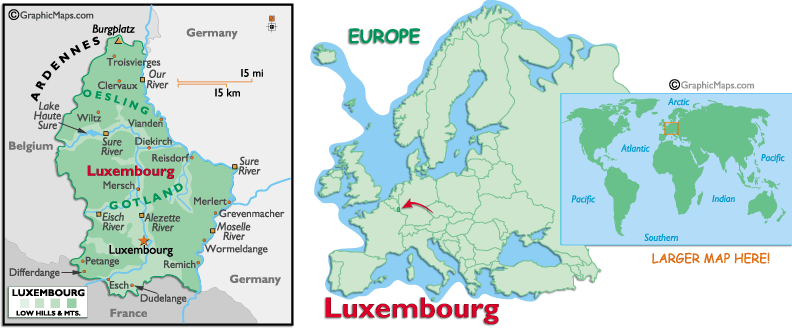
 Heidelberg, Germany and Luxembourg
Heidelberg, Germany and Luxembourg
 Heidelberg, Germany and Luxembourg
Heidelberg, Germany and LuxembourgApril 29th - May 1st 2006
My girlfriend Lori, was always complaining that I didn’t take her away for romantic weekends. “Whenever I suggest somewhere, you always say you’ve been there”. So over the English May bank holiday I agreed to take her to Europe for a 3 day road trip. Lori had never been to Germany or Luxemburg so I decided to give her an introduction as well as refilling my alcohol supplies with cheap European beer and wine. What? You think I was doing this trip for her!
I’m not sure if you’d class my method of transport as ‘romantic’ but we drove from Norwich to Dover on the Friday night after work in under 4 hours to catch a 10pm Norfolk Lines crossing to Dunkirke on the French/Belgium border. Despite the new luxurious ferry, I snored my way across the two hour crossing. We arrived at 1am French time.
Lori piled into a sleeping bag on the back seat and I drove aggressively (90-100mph) overnight on empty roads from Dunkirke – Lille – Mons – Charleroi – Namur crossing into Luxembourg at 4.30 am and into Germany at 5.08am driving on the autobahn past Saarbrucken. By 6.30am as the sun rose, I was zapped and crashed in a German lay by outside Mannheim for 2 hours kip. Lori had slept all the way. Nice work if you can get it. Heidelberg, our destination, was only an hour way.
I had last visited Heidelberg in 1987 when I took Malaysian tourists on 30 days tours of Europe’s highlights in a red London Double Decker bus. “Its Tuesday, it must be Belgium”. On our itinerary, we left Belgium, did a cruise down the Rhine and then headed for Heidelberg before moving onto Bavaria. I had never forgotten Heidelberg. The problem with Germany is that so much was destroyed during World War Two and post war development has spawned endless faceless industrial cities, but Heidelberg was lucky to be spared and retained something of the original German spirit.
“Home to Germany’s oldest University (founded 1386), Heidelberg is majestically set on the banks of the swift-flowing Neckar between ranges of wooded hills, around 70km south of Frankfurt. It has been seducing travellers since the first ‘Grand Tours’” (Rough Guide). We managed to park for free near the Central railway station on some abandoned land (the town is surrounded by pay car parks but I always find free parking everywhere!) and walked by the picturesque river. The opposite hilly side was covered in large medieval mansions.
Heidelburg seemed to have everything a romanticized German town required; narrow, cobblestone streets flanked by intricate Baroque architecture; market squares edged with outdoor cafes; densely wooded mountains threaded with trails; and picturesque castle ruins overlooking it all.
Reaching the Karl-Theodor Bridge, we passed through its fabulous arched gateway, bordered by two cylindrical Baroque Towers. The towers, one of which holds several dungeon cells, were once part of the medieval town fortification. The stone bridge , which spans the River Necktar, was completed in 1788. From the bridge, we got our first views of the castle, rising above the tree tops, its crumbling façade, a testament to it’s 500 year history. I was surprised to see coach loads of Japanese and Chinese tourists filling the bridge. Nearby, there was a square full of local stalls and we ate a brunch of German “sausages im brot” (in bread). For a traditional German town, it was strange to see Thai restaurants, Irish pubs and fast food joints.
The centrepiece of Heidelberg is the Schloss (castle), a compendium of magnificent buildings, somehow increased in stature by their ruined condition. There is a nice steep walk up a cobbled lane (Burgweg) to the entrance.
When you arrive, one of the most striking structures is the Renaissance-era Ottheinrichsbau, built in 1556. Its façade is a carnival of ornate pilasters, columns and statues with two lone figures standing guard high above. Behind the façade, the top two levels of the building are missing; their windows open into thin air, revealing only sky beyond. The structure was intact until 1764 when a lightening-induced fire destroyed most of the castle. Nearby, the Friedrichsbau, built in 1607, is equally elaborate, bursting with statues of royal ancestors of Friedrich IV, who had it built.
The Schlosshof holds a group of Renaissance Palaces, including the diverting Pharmacy Museum and the Grosses Fass, an enormous wine-barrel built in 1751 from 130 oak trees capable of holding 220,000 litres. Apparently, it is the largest wooden barrel in the world and would keep me in wine for at least a year. The keg is guarded by a statue of Perkeo – court jester and keeper of the royal wine keg. He was a legendary ‘piss head’ who allegedly died when he drank a glass of water. Big mistake.
At the southeastern corner is the most romantic of the ruins, now generally known as the Gesprengter Turm; a collapsed tower lies intact in the dried moat. This led to the Gun Garden, today full of blooming daffodils. There were breath-taking views of the town next to the river. In 1878, Mark Twain stood here and wrote “I have never enjoyed a view which had such a serene and satisfying charm about it as this one gives.” Twain became Heidelberg’s first unofficial PR person.
Back down in the centre, the Aldstadt’s finest surviving buildings are grouped on Marketplatz, in the middle of which is the sandstone Heiliggeistkirche with tiny shopping booths between its buttresses. This is the 600 year old Church of the Holy Ghost which contains the 15th century tombs of the church’s founder, King Ruprecht III and his wife, Elizabeth with their carved likenesses.
Nearby, the Hotel zum Ritter, built in 1592, with its Renaissance columns, curlicues and carved figures created a dazzling display. Since we had descended from the castle, the streets had filled up with tourists and Saturday tourists. We never found the statue to Robert Bunsen, Heidelberg resident and inventor of the Bunsen burner. Instead, we invaded the 1 Euro shops and made fun of the World Cup tat on sale. Germany would be hosting the event in less than a month and there was a shit-load of stuff to peddle except British flags.
The everitatsplatz, the heart of the old town, is flanked by the eighteenth century Alte Universitat and the Neue Universitat. The famous buildings were off set by the fact that the finish of the Heidelberg Half Marathon was due here tomorrow. It was tempting for me to stay, but I had promised a ‘romantic’ weekend. So far, Lori had been given a sausage for breakfast and treated to the castle (3 Euros).
Late afternoon, as the tourists packed the streets (lots of Chinese bus tours), we left Heidelburg and headed west. Mannheim was the nearest major city off the autobahn and we went looking for a hypermarket. There was a massive ‘May Market’ advertised everywhere which we saw, but didn’t enter. We went round and round Mannheim, cursing the never-ending parade of ‘May Market’ signs but none back to the autobahn. Eventually we found our road and a decent hypermarket outside Mannheim in which to fill the car up with crates of ‘Weissbeer’ (Wheat beer) and German sausage.
We drove to the Luxembourg border and sought accommodation in the villages around Trier by the river Moselle. Off a backstreet, lay a family run bed and breakfast. The village seemed closed apart from two restaurants. One was packed and booked up for the evening. The other was completely empty. We were forced to eat alone in the empty, silent one but the schnitzel, salad and chips were excellent as was the local Bitbeer. Not exactly a candlelit dinner but better than a take away kebab!
The following morning, Sunday, we found the dining room heaving with guests and we tucked into a typical German breakfast of meats, cheeses, rye bread and rolls. Then it was less than 20 minutes into Luxembourg and onto the capital, the imaginatively named, Luxembourg City.
Luxembourg was a European duchy that was initially established in 963AD and was captured by the Dukes of Burgundy in 1443. For the next four centuries it was repeatedly dominated by foreign princes from Burgundy, Spain, France, Austria and the German Confederacy who all improved the defences with three rings of battlements, 24 forts and 23km of underground workings. The Grand Duchy was eventually demilitarised in the early 19th Century when most of its walls and tunnels were destroyed. The Grand Duchy of Luxembourg is one of Europe’s smallest sovereign states, a tiny principality, with a population of about 430,000. I had last visited Luxembourg in 1997 on a ‘let’s do as many countries as possible’ roadtrip. Most of the time was spent driving outside the capital.
Luxembourg City is one of the most spectacularly sited capitals in Europe. The valleys of the rivers Alzette and Petrusse, which meet here, cut a green swathe through the city, their deep canyons once key to the city’s defences, but now providing a beautiful setting. Currently, there are half a dozen cranes dominating the horizon, dealing with the latest constructions. We spent most of the day exploring the attractive centre, which surprisingly was also full of bus tours.
The valley is dominated by the Adolphe Bridge built in 1903, as it over-hanged a large expanse and parks full (at this time of year) of daffodils and tulips. From here you can see that the city occupies an ideal defensive position and its defences were reinforced on many occasions – hence the massive bastions and subterranean artillery galleries of today known as the Petrusse fortifications or ‘Casements du Bock’ which date back to 1644 and the Spanish era. 20km of the underground tunnels are still accessible today but the tourists only get to clamber around part of it with lookouts over the river and valleys on either side. This is now an UNESCO World Heritage Site and an enjoyable visit – full of tunnels and dug outs.
The Cathedral of Notre Dame (1870) dominated the skyline with its flamboyant Gothic style of three pointed towers. We entered to find a commencement service going on with families stood to watch their kids get the treatment. There were beautiful stained glassed windows and lots of lit candles. I had never seen a commencement service before and the choir and organ bought the building to life. It was even stranger to see a Vietnamese family there with the young male on his mobile phone hid behind a stone pillar. I will always remember Luxembourg for this service.
The Old Town focuses on two squares, the more important of which is the Palace d’ Armes, fringed with cafés and restaurants. Apparently, this is the capital’s social centre but on a dreary Sunday morning, you wouldn’t have known it. More non descript fast food restaurants in-between the traditional outdoor cafes. The Hotel de Ville (Town Hall) built in 1838 in a neo classical style, looked impressive despite the adjoining square packed full of portable stalls for the evening fair.
The most impressive building was the Grand-Ducal palace – an architectural and historical monument. Built in 1573, it was a town hall and then got a glorious 19th Century makeover in ‘French Renaissance’ style. It is by far, the most impressive building in Luxembourg City, complete with royal guards doing silly walks outside. As I took in the marvellous view, I overheard a couple of American women expressing their disappointment in their tour. “Is this all there is? I thought there would be a lot more”. They had obviously not bothered to explore the backstreets.
If they had, they would have discovered the ancient Fish Market (Marche aux Poissons) in the heart of the old town situated at the crossroads of Roman roads. Most of the buildings date from the 18th Century but ‘Um Bock’ was an original 13th Century building. I guess they needed a shopping mall to make the place worth visiting.
They also probably missed the ‘Promenade de la Corniche’ which incorporates the magnificent ramparts built by the Spanish and French in the 17th Century full of aristocratic residences, renovated buildings, the Alzette Valley and splendid lower town below which is dominated by the St Jean Baptiste Church.
The northern part of Luxembourg boasts charming scenery in the green forested hills of the Ardennes. We drove to the magnificent chateau at Vianden in the far north as a heavy thunderstorm filled the skies with black clouds. Against the backdrop of the forested valley, it looked enormous. The village itself was a twinky affair, renovated for the tourists with cobbled stones and painted frame houses. I thought it was the best thing I’d seen in Luxembourg and vowed to return for a weekend of walking around the Ardennes.
We followed the twisty river valley through forested slopes and past lots of camping sites as snow started to fall. It was strange to see such weather at the end of April. We were passing very close by the German border and the garages were full of German cars crossing over to take advantage of the cheap petrol. Eventually, we reached St Vieh and found the motorway which allowed us to retrace our original roué via Leige – Namur – Charleroi – Mons- Lille - Dunkirke . Once out of Luxembourg, the sun returned.
Checking into a plastic Formula 1 hotel next to a Carrefour Hypermarket in Dunkirke which had a special price on offer (romance knows no bounds with Bob Jack), we felt prepared for a morning’s shopping before the ferry home. Nothing was open in Dunkirke on the Sunday evening except for a ‘Frite’ shop which was packed with locals. There were menus on the wall but we looked to see what everyone else was ordering. We ended up with the two largest portions of chips you would ever think of buying (Supersizing McDonalds didn’t even come close) alone with a large burger and kebab. For the first time as long as I remember, I left half my meal. It was that big. And I eat a lot!
On a rainy Monday May 1st, we discovered that the hypermarket was closed for a public holiday. Panic! We started to drive towards Calais in a last minute bid to find something open. Mid way, I took a guess, turned off towards a village and found a small supermarket open. It had all the usual French foodstuffs along with wine and we were able to stock up on the essentials.
The return journey was made more interesting by the fact that we queued up for ever on the French side to board, which forced the ferry to leave late and contend with rough seas (some kid relieved his stomach as I gorged on French sausage and cheese) and then when we arrived in Dover, there was a problem with the docking gear. We hung around at sea for nearly two hours waiting for a free berth. A 90 minute crossing took 4 hours. But that’s travel. You win some and lose some.
I’d recommend both Heidelburg and Luxembourg if you are passing through Europe. Heidelburg retains enough German character and lovely buildings to feel as if you are still in touch with centuries gone past. Luxembourg is more sterilised, tidy and modern but the Ardenne forests are lovely. I will be going back there to do some walking one weekend. Maybe Lori will eventually get her romantic weekend. Maybe…

